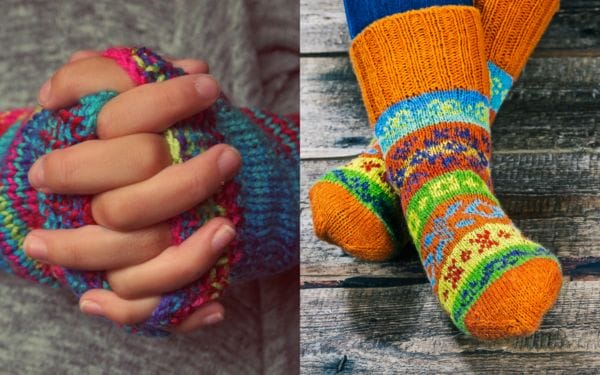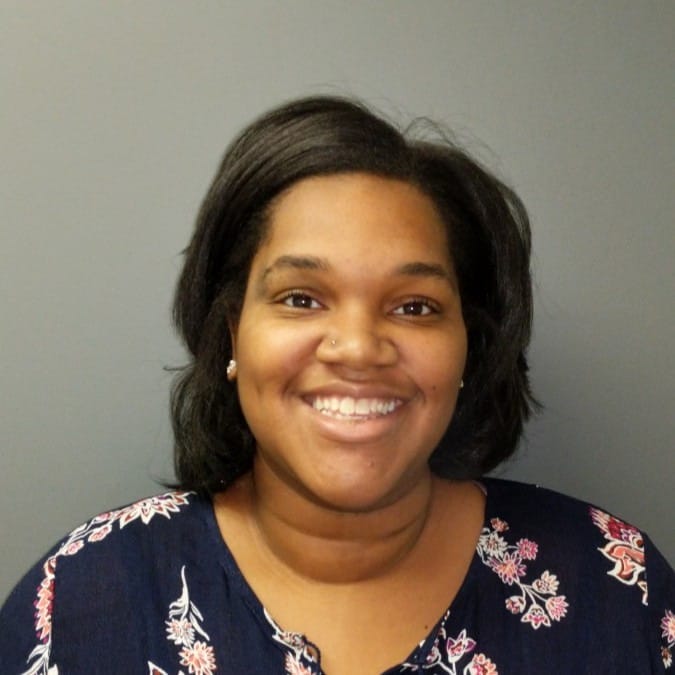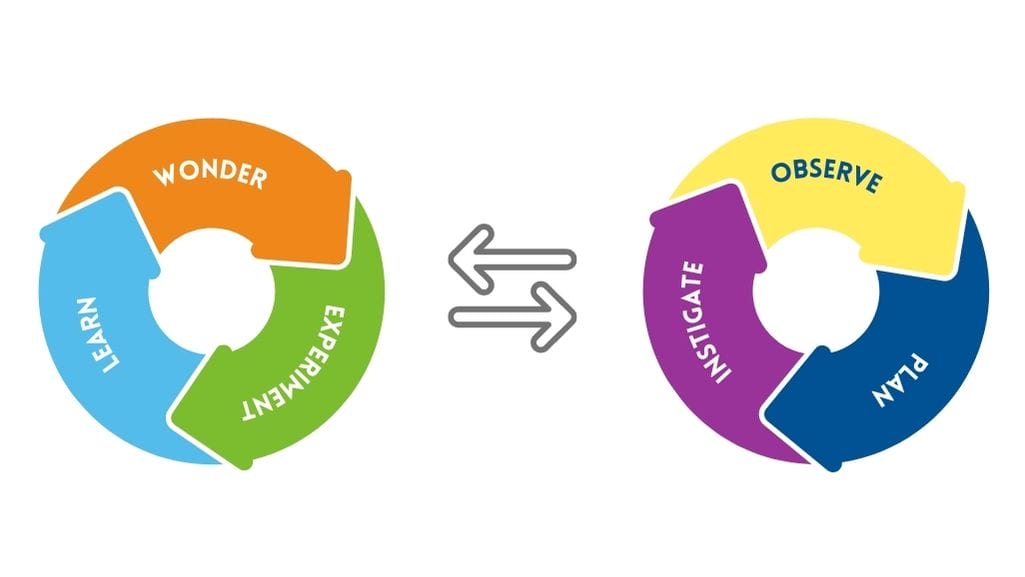If you try this activity with your student(s), we’d love to see what you do. Share your journey via the #Inspired2Learn hashtag on your preferred social platform.
Created by: Jenna Fournel and Aleta Margolis
Discipline: A useful activity across all disciplines that require retelling or demonstrating understanding of concepts that have been taught.
Age level: Elementary through High School
Time: 10-20 minutes
Materials: None
Learning to listen deeply may very well be one of the most important skills we can cultivate as members of a community. One of the ways we can demonstrate our understanding of what we hear, is by sharing back what was said. This activity challenges listeners to share back what they hear without words and provides the speakers with a unique glimpse into how what they said was received.

What to Do:
The structure of this activity can be adapted in many ways, some of which are listed below under variations and extensions.
- Students partner up and decide who will be A and who will be B.
- A’s make up a story to tell B’s beginning with, “Once upon a time…”
- B’s listen closely to the story.
- After three minutes pass, say: “Freeze, now B’s your job is to retell this story to A’s in as much detail as possible, using only your hands. Go!” Emphasize that no other part of the body should be used in this storytelling, including their face.
- Pause to debrief asking the whole class:
- A’s, what did it feel like to have your story told back to you in this way?
- B’s, what did it feel like to have to tell a story without any words?
- Partners switch jobs. “Now B’s it’s your turn to make up a story to tell A’s – using your voice!”
- After three minutes pass, say: “Freeze. Now As, it’s your job to retell Bs story in as much detail as possible, using only your feet. Go!”
- Pause to debrief asking the whole class questions like:
- B’s what did it feel like to have your story told back to you in this way?
- A’s what did it feel like to have to tell a story without any words?
- What skills did you each have to use to tell and retell your stories?
Variations and Extensions:
Consider doing this activity as a means of having students demonstrate understanding of content. For example:
- Using their body parts to show one another how a particular mathematical or scientific concept works and getting feedback from their partners on what actions conveyed these concepts.
- Retelling a particular event in history or in a book or story you are reading in class, having partners trade-off as they make their way through the plot.
- Explaining the rules of a field game for PE using only hands or feet.
Consider having students retell using different body parts or methods such as:
- Facial expressions
- Whole body
- Sounds
- Creating tableaux using a variety of objects
- Emojis
Inspired Teaching Connection
This activity is inevitably Joyful as students delight in seeing their stories retold and find an element of silliness in telling a story with one’s toes. But it is also deeply rooted in Students as Experts because the students are creating the stories themselves and then using their own creative thinking to solve the challenge of retelling without words. Nobody can be wrong in this activity which means students can find confidence in whatever they bring to the experience. In addition to these two Core Elements of the Inspired Teaching approach, Mutual Respect occurs when the teller sees that they were heard by the listener and then has the opportunity to do the same in a switched role. Each of the 4Is, Intellect, Inquiry, Imagination, and Integrity, is at play as students observe, listen, and learn from the observations and wonderings of their peers.
See our instructional model here.
Standards Addressed by this Activity
Common Core College and Career Readiness Anchor Standards for Speaking and Listening
Comprehension and Collaboration:
CCSS.ELA-LITERACY.CCRA.SL.1 Prepare for and participate effectively in a range of conversations and collaborations with diverse partners, building on others’ ideas and expressing their own clearly and persuasively.
CCSS.ELA-LITERACY.CCRA.SL.2 Integrate and evaluate information presented in diverse media and formats, including visually, quantitatively, and orally.
CCSS.ELA-LITERACY.CCRA.SL.3 Evaluate a speaker’s point of view, reasoning, and use of evidence and rhetoric.
Presentation of Knowledge and Ideas:
CCSS.ELA-LITERACY.CCRA.SL.4 Present information, findings, and supporting evidence such that listeners can follow the line of reasoning and the organization, development, and style are appropriate to task, purpose, and audience.
Common Core College and Career Readiness Anchor Standards for Reading
Key Ideas and Details
CCSS.ELA-LITERACY.CCRA.R.3 Analyze how and why individuals, events, or ideas develop and interact over the course of a text.
Craft and Structure:
CCSS.ELA-LITERACY.CCRA.R.6 Assess how point of view or purpose shapes the content and style of a text.
Integration of Knowledge and Ideas:
CCSS.ELA-LITERACY.CCRA.R.7 Integrate and evaluate content presented in diverse media and formats, including visually and quantitatively, as well as in words.
Common Core Standards for Mathematical Practice
Make sense of problems and persevere in solving them.
CCSS.MATH.PRACTICE.MP1 Mathematically proficient students start by explaining to themselves the meaning of a problem and looking for entry points to its solution. They analyze givens, constraints, relationships, and goals. They make conjectures about the form and meaning of the solution and plan a solution pathway rather than simply jumping into a solution attempt. They consider analogous problems, and try special cases and simpler forms of the original problem in order to gain insight into its solution. They monitor and evaluate their progress and change course if necessary. Older students might, depending on the context of the problem, transform algebraic expressions or change the viewing window on their graphing calculator to get the information they need. Mathematically proficient students can explain correspondences between equations, verbal descriptions, tables, and graphs or draw diagrams of important features and relationships, graph data, and search for regularity or trends. Younger students might rely on using concrete objects or pictures to help conceptualize and solve a problem. Mathematically proficient students check their answers to problems using a different method, and they continually ask themselves, “Does this make sense?” They can understand the approaches of others to solving complex problems and identify correspondences between different approaches.
Reason abstractly and quantitatively.
CCSS.MATH.PRACTICE.MP2 Mathematically proficient students make sense of quantities and their relationships in problem situations. They bring two complementary abilities to bear on problems involving quantitative relationships: the ability to decontextualize—to abstract a given situation and represent it symbolically and manipulate the representing symbols as if they have a life of their own, without necessarily attending to their referents—and the ability to contextualize, to pause as needed during the manipulation process in order to probe into the referents for the symbols involved. Quantitative reasoning entails habits of creating a coherent representation of the problem at hand; considering the units involved; attending to the meaning of quantities, not just how to compute them; and knowing and flexibly using different properties of operations and objects.
Collaborative for Academic, Social, and Emotional Learning Competencies
Self-Awareness: The abilities to understand one’s own emotions, thoughts, and values and how they influence behavior across contexts. This includes capacities to recognize one’s strengths and limitations with a well-grounded sense of confidence and purpose.
Self-management: The abilities to manage one’s emotions, thoughts, and behaviors effectively in different situations and to achieve goals and aspirations. This includes the capacities to delay gratification, manage stress, and feel motivation and agency to accomplish personal and collective goals.
Social awareness: The abilities to understand the perspectives of and empathize with others, including those from diverse backgrounds, cultures, and contexts. This includes the capacities to feel compassion for others, understand broader historical and social norms for behavior in different settings, and recognize family, school, and community resources and supports.
College, Career, and Civic Life (C3) Framework for Social Studies State Standards
Dimension 1: Developing Questions and Planning Inquiries
Dimension 1 features the development of questions and the planning of inquiries. With the entire scope of human experience as its backdrop, the content of social studies consists of a rich array of facts, concepts, and generalizations. The way to tie all of this content together is through the use of compelling and supporting questions. Questioning is key to student learning. The C3 Framework encourages the use of compelling and supporting questions, both teacher- and student-generated, as a central element of the teaching and learning process.



















